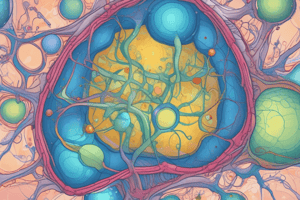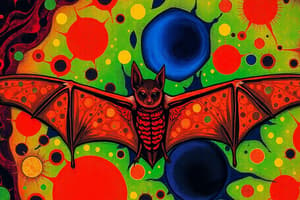Podcast
Questions and Answers
What types of cells can pluripotent stem cells produce?
What types of cells can pluripotent stem cells produce?
- All embryonic cell types excluding extraembryonic structures (correct)
- Only hematopoietic cells
- All embryonic cell types including extraembryonic structures
- Only mesenchymal and neural cells
What is a key characteristic of multipotent stem cells?
What is a key characteristic of multipotent stem cells?
- They can proliferate indefinitely in vitro.
- They can only differentiate into embryonic cells.
- They can become any type of cell in the body.
- They can give rise to multiple cell types within a specific organ. (correct)
What medical application does human embryonic stem (ES) cells have in regenerative medicine?
What medical application does human embryonic stem (ES) cells have in regenerative medicine?
- They can reproduce stem cells without ethical concerns.
- They can exclusively be used for hematopoietic diseases.
- They can generate any type of viable organism.
- They can produce specialized human cells for treating various diseases. (correct)
What is a challenge associated with using multipotent stem cells?
What is a challenge associated with using multipotent stem cells?
What ethical issue is associated with generating new embryonic stem cell lines?
What ethical issue is associated with generating new embryonic stem cell lines?
What factor was not found to be necessary for transforming somatic cells into pluripotent stem cells?
What factor was not found to be necessary for transforming somatic cells into pluripotent stem cells?
Which iPS cell application directly addresses vision loss?
Which iPS cell application directly addresses vision loss?
Which application is NOT associated with human embryonic stem cells?
Which application is NOT associated with human embryonic stem cells?
What is the primary cause of ischemic cardiomyopathy?
What is the primary cause of ischemic cardiomyopathy?
What can occur if allogeneic stem cells are used for transplantation?
What can occur if allogeneic stem cells are used for transplantation?
What is a limitation of using stem cells derived from adult tissues?
What is a limitation of using stem cells derived from adult tissues?
What procedure was performed on the 51-year-old male with ischemic cardiomyopathy?
What procedure was performed on the 51-year-old male with ischemic cardiomyopathy?
What potential benefit was observed in patients who received iPS cell-derived RPE cells?
What potential benefit was observed in patients who received iPS cell-derived RPE cells?
Which step is not involved in the application of iPS cell technology for cystic fibrosis?
Which step is not involved in the application of iPS cell technology for cystic fibrosis?
Which factor was demonstrated to be crucial in reprogramming somatic cells into pluripotent stem cells?
Which factor was demonstrated to be crucial in reprogramming somatic cells into pluripotent stem cells?
What disease is specifically linked to the degeneration of neurons controlling voluntary muscles?
What disease is specifically linked to the degeneration of neurons controlling voluntary muscles?
What define the capacity of stem cells?
What define the capacity of stem cells?
What type of cells have the ability to produce all embryonic cell types and extraembryonic structures?
What type of cells have the ability to produce all embryonic cell types and extraembryonic structures?
What is one significant outcome of the iPSC treatment in patients with LSCD?
What is one significant outcome of the iPSC treatment in patients with LSCD?
How did researchers in Japan create corneal epithelial cell sheets for LSCD treatment?
How did researchers in Japan create corneal epithelial cell sheets for LSCD treatment?
What indicates the advancement in regenerative medicine as mentioned in the study?
What indicates the advancement in regenerative medicine as mentioned in the study?
What learning goal relates to the difference between ES cells and iPSCs?
What learning goal relates to the difference between ES cells and iPSCs?
Which factor is NOT associated with the treatment efficacy of iPSCs in regenerative medicine?
Which factor is NOT associated with the treatment efficacy of iPSCs in regenerative medicine?
What is the potential future direction mentioned for iPSC therapy?
What is the potential future direction mentioned for iPSC therapy?
What is the primary advantage of autologous stem cell therapies?
What is the primary advantage of autologous stem cell therapies?
Who was responsible for demonstrating that fully differentiated somatic cells can be reprogrammed into an embryonic state through somatic cell nuclear transfer?
Who was responsible for demonstrating that fully differentiated somatic cells can be reprogrammed into an embryonic state through somatic cell nuclear transfer?
What was the result of John Gurdon's experiment with the Xenopus tadpole?
What was the result of John Gurdon's experiment with the Xenopus tadpole?
Which method was used by Yamanaka et al. to identify candidate pluripotency factors?
Which method was used by Yamanaka et al. to identify candidate pluripotency factors?
What technique was employed to introduce pluripotency factors into mouse ES cells?
What technique was employed to introduce pluripotency factors into mouse ES cells?
What role does the beta-geo cassette play in the assay system described by Yamanaka et al.?
What role does the beta-geo cassette play in the assay system described by Yamanaka et al.?
What is one reason that autologous stem cell therapies may be more time-consuming?
What is one reason that autologous stem cell therapies may be more time-consuming?
What is true about the Fbx15 gene used in the experimentation with mouse ES cells?
What is true about the Fbx15 gene used in the experimentation with mouse ES cells?
Flashcards
Induced Pluripotent Stem Cells (iPSCs)
Induced Pluripotent Stem Cells (iPSCs)
Adult cells reprogrammed to become pluripotent stem cells, capable of differentiating into various cell types.
Stem Cell Self-renewal
Stem Cell Self-renewal
The ability of a stem cell to divide and create more stem cells while maintaining their undifferentiated state.
Pluripotent cells
Pluripotent cells
Stem cells that can differentiate into many types of cells in the embryo, but not extraembryonic tissues like the placenta.
Stem Cell Differentiation
Stem Cell Differentiation
Signup and view all the flashcards
Multipotent cells
Multipotent cells
Signup and view all the flashcards
Totipotent Stem Cell
Totipotent Stem Cell
Signup and view all the flashcards
Somatic Cell Reprogramming
Somatic Cell Reprogramming
Signup and view all the flashcards
Embryonic Stem Cells (ESCs)
Embryonic Stem Cells (ESCs)
Signup and view all the flashcards
Regenerative Medicine
Regenerative Medicine
Signup and view all the flashcards
Limbal Stem Cell Deficiency (LSCD)
Limbal Stem Cell Deficiency (LSCD)
Signup and view all the flashcards
Pluripotent Stem Cell
Pluripotent Stem Cell
Signup and view all the flashcards
Disease Modeling
Disease Modeling
Signup and view all the flashcards
Immune Rejection
Immune Rejection
Signup and view all the flashcards
Somatic Cell Nuclear Transfer (SCNT)
Somatic Cell Nuclear Transfer (SCNT)
Signup and view all the flashcards
Allogeneic Therapy
Allogeneic Therapy
Signup and view all the flashcards
Ethical Concerns (Stem cells)
Ethical Concerns (Stem cells)
Signup and view all the flashcards
Autologous stem cell therapy
Autologous stem cell therapy
Signup and view all the flashcards
Pluripotency factors
Pluripotency factors
Signup and view all the flashcards
Embryonic stem cells (ES cells)
Embryonic stem cells (ES cells)
Signup and view all the flashcards
Somatic cells
Somatic cells
Signup and view all the flashcards
Cloning (SCNT)
Cloning (SCNT)
Signup and view all the flashcards
Reprogramming
Reprogramming
Signup and view all the flashcards
ES cell resistance to G418
ES cell resistance to G418
Signup and view all the flashcards
Somatic cell sensitivity to G418
Somatic cell sensitivity to G418
Signup and view all the flashcards
Fbx15 locus activation
Fbx15 locus activation
Signup and view all the flashcards
iPS cell generation
iPS cell generation
Signup and view all the flashcards
Macular degeneration treatment
Macular degeneration treatment
Signup and view all the flashcards
Ischemic cardiomyopathy treatment
Ischemic cardiomyopathy treatment
Signup and view all the flashcards
Genetic disease treatment (example: CF)
Genetic disease treatment (example: CF)
Signup and view all the flashcards
Disease modeling with iPS cells
Disease modeling with iPS cells
Signup and view all the flashcards
Study Notes
Induced Pluripotent Stem Cells (iPSCs) and Cancer
- A groundbreaking study successfully used iPSCs to treat severe corneal damage caused by limbal stem cell deficiency (LSCD).
- Researchers reprogrammed donor blood cells into iPSCs and developed corneal epithelial cell sheets.
- These were transplanted into the eyes of four patients.
- A two-year observation period showed no major adverse effects (e.g., tumor formation or immune rejection).
- Most patients experienced significant improvements in vision and corneal health.
- This advances regenerative medicine, paving the way for more clinical trials.
Stem Cells
- Stem cells have a dual capacity for self-renewal (dividing while staying undifferentiated) and differentiation (developing into specialized cells).
- Potency classifies stem cells based on their differentiation capacity.
- Totipotent cells can produce all cell types (including extraembryonic tissues like the placenta) and form a whole organism.
- Pluripotent cells can create all cell types but cannot form extraembryonic tissues. Embryonic stem cells (ESCs) are a type of pluripotent stem cell.
- Multipotent cells can produce multiple cell types within a specific tissue or organ. Adult stem cells are often multipotent, including hematopoietic, mesenchymal, and neural stem cells.
iPSC Development and Applications
- Somatic cell nuclear transfer (SCNT) demonstrates that mature somatic cells can be reprogrammed into embryonic stem cells.
- In 1958, John Gurdon transferred genetic material from a tadpole cell into an enucleated egg, creating a new tadpole.
- Yamanaka et al. identified key pluripotency factors (KLF4, Sox2, Oct3/4, and c-myc) necessary and sufficient for reprogramming somatic cells to induced pluripotent stem cells (iPSCs).
- iPSCs have potential in regenerative medicine, enabling the creation of various specialized human cells for disease treatment and injuries.
- iPSCs are also useful in drug discovery, modeling diseases (like ALS), and performing genetic modifications to study the effects.
Macular Degeneration and Ischemic Cardiomyopathy
- Macular degeneration is a leading cause of vision loss in the elderly, resulting from retinal pigment epithelial degeneration.
- iPSC-derived retinal pigment epithelial (RPE) cells can potentially repair damaged cells leading to better vision.
- iPSC-derived cardiomyocytes can potentially treat Ischemic cardiomyopathy, a heart disease where heart muscle cells die due to lack of blood flow.
Studying That Suits You
Use AI to generate personalized quizzes and flashcards to suit your learning preferences.
Related Documents
Description
Explore the use of induced pluripotent stem cells (iPSCs) in treating severe corneal damage. This quiz covers the transformative research that leverages iPSCs for regenerative medicine, highlighting patient observations and outcomes. Test your knowledge on the intricacies of stem cell biology and their potential in clinical applications.



